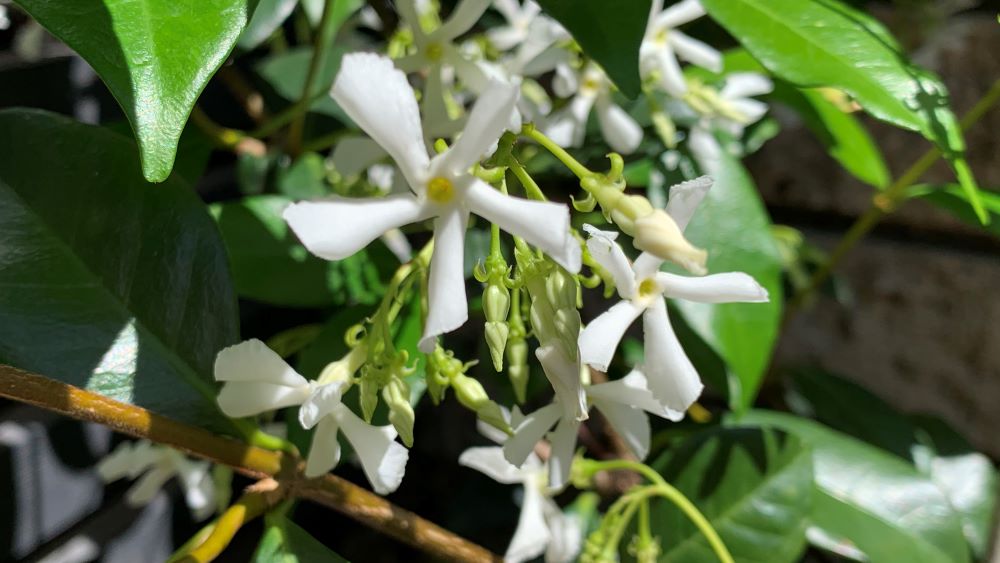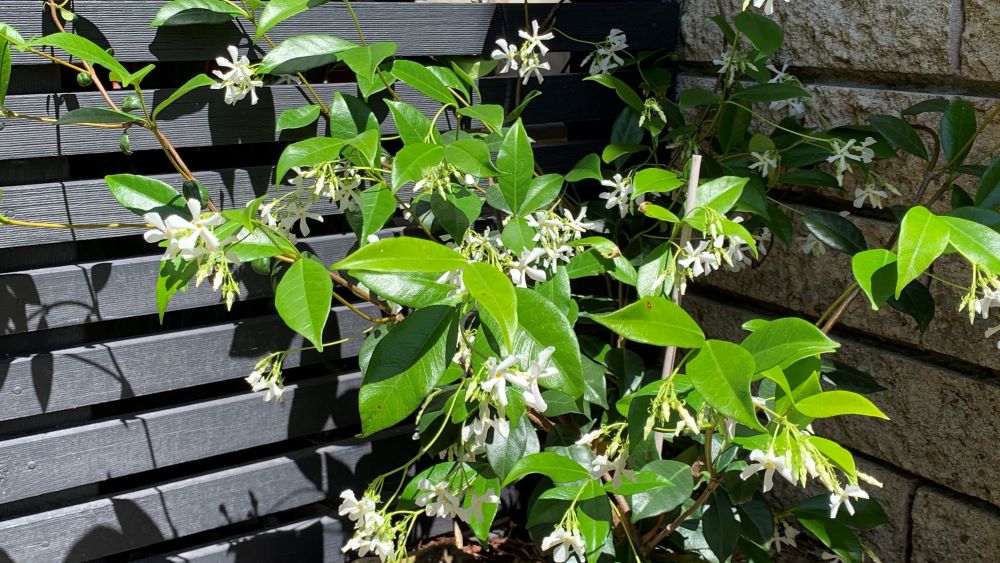Star jasmine can turn brown due to underwatering, a lack of nutrients, poor soil, or overwatering. Water star jasmine every week in spring and fall and increase this to twice per week in summer. Dress your star jasmine with aged cow manure and bark mulch and water it in well.
Star jasmine is a hardy plant that makes a great feature climbing over a screen, wall or pole. This article will explore all you need to know about why star jasmine turns brown and how to solve this problem.

Top 5 reasons why star jasmine turns brown
Here are the top 5 reasons why star jasmine turns brown and how to solve them.
1. Underwatering
The top reason why star jasmine turns brown is because they are lacking water. Not enough water will cause the roots to dry, the leaf tips to turn brown and the plant can eventually die off. While star jasmine are drought hardy once they are established they will need regular water when first planted.
If star jasmine are left to dry out when they are first planted they can turn brown quickly. They will be used to regular water after being in a nursery. Star by watering them every 2-3 days and then slow down the watering to once per week.
Star jasmine will grow best if they are planted in spring and fall as the weather will be mild and they will not dry out as quickly. Mulch them with bark mulch to keep the soil moist for longer and stop them from drying out.
2. Lack of nutrients
Lack of nutrients can cause star jasmine to turn yellow and then turn brown. Lacking a range of nutrients including iron, nitrogen and phosphorus can cause the plant can turn brown. Leaves will start to turn yellow and then brown and the flowers can also brown.
To solve this problem apply a handful of pelleted chicken manure to the plant. Top dress with 1 inch of aged cow manure and then top with bark mulch. Water the plant well to wash the nutrients down into the soil. This will give the plant a boost of a wide range of nutrients and help it to recover.

3. Poor soil
Poor soil can be an overall cause of brown leaves, stems and flowers. Sandy soil will lose water quickly and can cause the plant to dry out. Sandy soil is usually low in nutrients and can be too lean for star jasmine.
Clay soil too can be a problem as it can hold too much water, it won’t drain well and the plants can struggle to extract the nutrients they need.
The simple solution to overly sandy or clay soils is to add organic matter before planting your star jasmine. Dig through compost, aged cow manure and worm castings.
If your star jasmine is already in the ground you can add extra organic matter by top dressing. Use a mix of compost, cow manure and worm castings. These will bring worms into the soil who will dig through and naturally mix the organic matter through the soil.
Top this with some bark mulch to keep the top dressing moist and to protect the worms that will venture up to eat the organic matter and soil bacteria.
4. Overwatering
Overwatering can cause a star jasmine to turn brown. You will usually notice yellowing or blackening leaves as the first signs of overwatering. As this gets worse, the leaves will turn from black or yellow to brown as they die off.
Roots can be damaged by too much water, causing them to rot and they will struggle to absorb the nutrients they need. A lack of nitrogen can cause the leaves to turn yellow, as the roots cannot absorb this nutrient.
The simple solution to this is to add more mulch, up to 2-3 inches deep. Use bark mulch as this will absorb excess water from the soil and rain. Add some slow release fertilizer like pelleted chicken manure and slow your watering schedule.
In winter you may not need to add water to your plant at all. Check the soil moisture with your finger or with a spade to see if it is damp. Only add water once the soil is dry and if there is low rainfall.
5. Pest attack
Aphids are a common pest that can attack the new growth on star jasmine. The new delicate stems are a tasty treat for the tiny, green aphids which suck the sap out of the star jasmine. If they are left and overtake the plant, they can cause damage, causing the stems and leaves to turn brown.
You can leave the aphids for 1-2 days to see if ladybugs move in. A ladybug can move in and eat up to 50 aphids in a few hours. This can control the aphids naturally without needing to do anything else.
Aphids that are not taken care of by ladybugs can be treated with neem oil. This oil will coat the aphids and can deal with them within a week. Spray them again with neem oil a week or two later to remove any aphids that are remaining.

Why star jasmine turns brown | Summary
Star jasmine will turn brown for many reasons but the most common is underwatering. A lack of water can cause the leaves, flowers and stems to turn brown. The solution is a simple combination of top dressing with aged cow manure, a handful of pelleted chicken manure, some bark mulch and water well.
You can trim off any damaged, brown leaves and flowers and put them in your compost. Star jasmine can quickly recover and you can expect a big coverage of beautiful flowers early in the next spring.
Happy growing.
I am an accredited practicing dietitian, experienced gardener and a dedicated cook. I love writing and sharing my experience so you can learn from my successes and mistakes.
